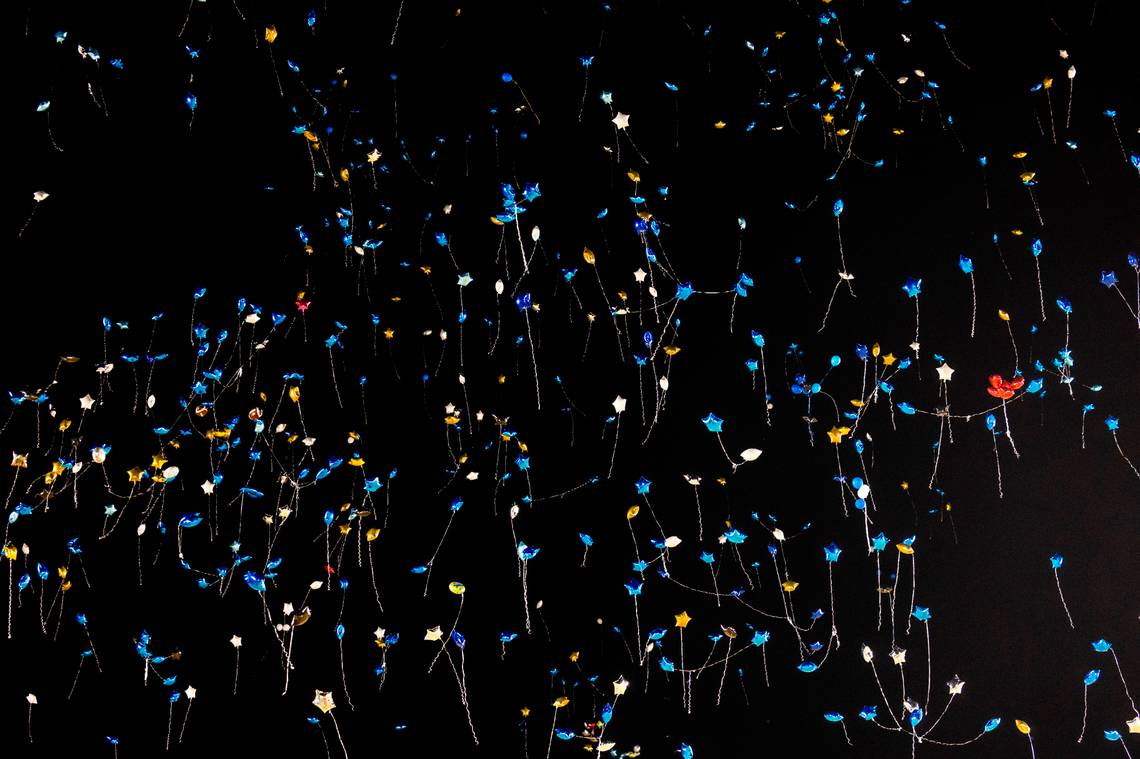If you’re considering a balloon release to commemorate a milestone birthday, anniversary or graduation, you should know that even as they do float majestically up, they must then come down, sometimes drifting across several state lines before they lose their buoyancy or freeze and burst.
By some estimates, millions of balloons are released in the U.S. every year, and each one eventually drops indiscriminately back, hitting the ground, a body of water, a tree, or a power line.
“Unfortunately, a lot of people don’t consider this litter, but it absolutely is,” said David Mumford, superintendent of Falls Lake State Recreation Area north of Raleigh, where balloon releases happen regularly despite being prohibited.
“There are some very meaningful reasons to want to have a balloon release,” Mumford concedes. “But I think most people wouldn’t just pop 50 balloons, leave them on the ground and walk away. They don’t think that’s what they’re doing.
“But those balloons end up as trash somewhere, and they can affect wildlife. They just end up as litter on the ground.”
What’s the harm in releasing balloons?
Helium-filled balloons come in two types: latex, which may be made of natural latex extracted from rubber trees, or of synthetic latex made from petroleum compounds; and “foil” balloons, made from a “metalized” polyester film.
Foil balloons should never be released. Tangled in power lines, they can cause outages. Their components don’t break down, so they last indefinitely.
Latex balloons may disintegrate, but the process can take many months. In the meantime, biologists say:
▪ The balloons look like food to some animals, particularly if they end up near or in water where they may float and move in the current like living organisms.
▪ Shorebirds, fish sea turtles and some mammals have been known to eat them.
▪ The problem appears to be growing. In 2023, biologists at Cape Hatteras National Seashore reported 1,786 balloons were picked up along the Seashore, up from 733 the year before.
▪ Some environmentalists say the use of helium for balloons is a waste of the non-renewable gas, which has scientific and medical applications including serving as a necessary coolant for magnetic resonance imaging (MRI) machines.
Why are balloons so bad for sea turtles?
Sea turtles, which eat jellyfish, are especially attracted to the bright colors and lifelike movement of balloon remnants floating in the ocean, marine biologists say. Balloon bits can block a turtle’s digestive system, killing the turtle or sickening it and making it more susceptible to predators.
Strings tied to balloons add to the problem. Birds can get entangled in the strings and be strangled or immobilized. If ingested, the strings can cause an animal’s intestines to twist.
“Turtles are swimming around, the balloon is moving around. It looks like something good to eat, and the turtle needs to keep on moving,” said Kathy Zagzebski, executive director of the Karen Beasley Sea Turtle Rescue and Rehabilitation Center in Surf City, “The turtle doesn’t really have a lot of time to try to distinguish, ‘Is that something good, or something bad?’ They just gobble i up.”
Zagzebski remembers two turtles the center took as “patients” in 2022 that had ingested balloons, including a Kemp’s ridley, the rarest of the seven sea turtle species, which had swallowed a balloon and more than two feet of ribbon. Both turtles survived and were later returned to the ocean.
Are balloon releases legal?
Some states have banned mass balloon releases, like the one in Cleveland, Ohio, in 1986 when a charity set loose a world-record 1.5 million helium-filled balloons.
North Carolina has no statewide ban, though recently the towns of Surf City and Topsail Beach have established ordinances banning the release of balloons. Violators are subject to fines of $250.
What are some alternatives to balloon releases?
Kris Robbins, who operates Carolina Balloons and has provided balloons for events all over the country, doesn’t do releases and says he discourages potential customers from doing them because of the potential environmental harm.
Balloon decor and balloon drops are his specialty, using air-filled orbs instead of helium with the balloons coming down over a roomful of celebrants, not going up into the sky.
If an event does call for helium balloons to be used outside, Robbins said, weights are used to keep the balloons from escaping.
Robbins said he also doesn’t do “confetti shoots” at outdoor events because complete cleanup of the material is nearly impossible.
Instead of outdoor balloon releases, Robbins and other say:
▪ Use air-filled latex balloons that can be punctured and put in the trash after an event.
▪ Always place weights on helium-filled balloons if they’re used outside to prevent escape.
▪ Save foil balloons for reuse; they can be re-filled with helium and used again.
▪ Instead of shooting confetti at an outdoor event, shoot streamers, which come in 25-foot lengths and are colorful but easily collected and put in the trash.
▪ If you must use confetti at an outdoor event, use rice-paper confetti that biodegrades. Don’t use plastic or foil confetti, and avoid glitter, which is made of plastic. (None of these are allowed in most public parks, because even if they disintegrate, it won’t be before the next park users arrive hoping to experience the natural setting.)
▪ Release butterflies instead of balloons. There are several butterfly farms in North Carolina.
▪ Blow bubbles, either using the dip-and-puff method from a bottle or with battery-operated bubble-makers (some of which, ironically, are shaped like guns).
Want to help clean up balloons and other trash?
▪ The Town of Oak Island has several community beach cleanup events scheduled this year – the next one is May 4 – and other communities across the state organize their own.
